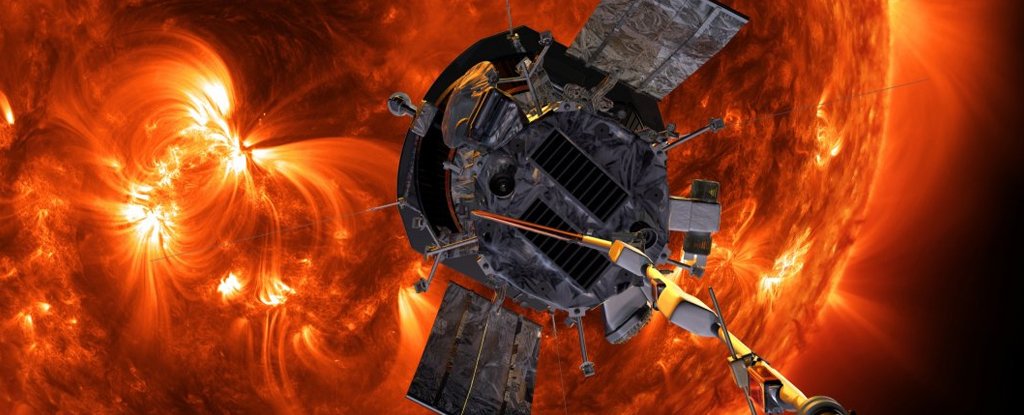Touching a star isn’t easy. The sun is an enormous, searing-hot orb of plasma that generates a chaos of magnetic fields and can unleash deadly blasts of particles at a moment’s notice.
But that is precisely what NASA plans to do – 24 times or more – with its car-size Parker Solar Probe (PSP).
The goal of the AU$2 billion (US$1.4 billion) mission is to edge within 4 million miles (6.4 million kilometres) of the sun, which is close enough to study the star’s mysterious atmosphere, solar wind, and other properties.
Information gathered by the probe may help space weather forecasters better predict violent solar outbursts that can overwhelm electrical grids, harm satellites, disrupt electronics, and possibly lead to trillions of dollars‘ worth of damage.
The spacecraft is slated to launch from the Florida coast on Saturday at 3:33 am EDT, should weather cooperate, though NASA has through August 23 to fire off its probe. PSP will reach the sun a few months after launch.
Here are some of the brutal conditions and tremendous challenges NASA’s probe will have to survive to pull off its unprecedented mission.
The tricky process of touching a star
The first hurdle PSP needs to clear is Earth itself.

The orbital path that NASA’s Parker Solar Probe will have to fly (Johns Hopkins University Applied Physics Laboratory)
To make the trip, the probe will ride atop a Delta 4 Heavy rocket, which is one of the most powerful operational launch vehicles on Earth (though not quite as powerful as SpaceX’s new Falcon Heavy system).
NASA chose the rocket because it’s surprisingly hard to get to the sun, which is 93 million miles (150 million kilometres) away.
Earth orbits the sun at a speed of 107,000 kilometres (66,500 miles) per hour, and so does anything launched off of the planet. To fall toward the sun, PSP will have to slow down by 85,000 kilometres (53,000 miles) per hour, NASA said in a video about its mission.
Three different rocket stages (one firing after the other runs out of fuel) in the Delta 4 Heavy will help considerably with boosting PSP toward that goal, but it’s not enough to repeatedly fly the probe close to the sun.
Instead, the rocket will shoot the probe on a path toward Venus, a planet it will fly past seven times over six years. The world’s strong gravitational field will help gradually absorb PSP’s “sideways motion” imparted by Earth and direct it closer and closer to the sun.
The consequence of this orbital dance is that PSP will fall toward the sun faster and faster after each pass. On its first orbit of the sun in November 2018, the probe will be some 15.4 million miles (25 million kilometres) from the sun.
About 21 orbits later, in December 2024, it will sneak within 4 million miles (6.4 million kilometres) of the sun, travelling at a speed of nearly 692,000 kilometres (430,000 miles) per hour relative to the star.
Achieving such a velocity would make PSP the fastest a human object in space.
It’s nearly 120 miles (193 km) per second – fast enough to fly from New York to Tokyo in less than a minute – and 3.3 times as fast as NASA’s Juno spacecraft, which zips past Jupiter at speeds of 209,000 kilometres (130,000 miles) per hour.
How to fly through hell and back
During its journey, PSP must withstand sunlight 3,000 times more powerful than occurs at Earth. Outside the spacecraft, in the outer fringes of the sun’s corona or atmosphere, temperatures may reach 1,371 degrees Celsius (2,500 degrees Fahrenheit)– hot enough to liquify steel.
The probe also must contend with a “solar wind” of charged, high-energy particles that can mess with electronics.
The key to protecting the probe, as well as its sensors for measuring the sun’s magnetic fields and solar wind, is a special heat shield called the Thermal Protection System.
Made of 4.5 inches (11.5 centimeters) of carbon foam sandwiched between two sheets of carbon composites, the eight-feet-wide shield will absorb and deflect solar energy that might otherwise fry the probe.
A water cooling system will also help prevent the spacecraft’s solar panels from roasting and keep the spacecraft a cosy 85 degrees Fahrenheit (29 degrees Celsius).
PSP’s mission is to crack two 60-year-old mysteries: why the sun has a solar wind at all, and how the corona – the star’s outer atmosphere – can heat up to millions of degrees.
Both factors are key to understanding what leads to potentially devastating solar storms.
“That defies the laws of nature. It’s like water rolling uphill,” Nicola Fox, a solar physicist at the Johns Hopkins University Applied Physics Laboratory, said during a NASA briefing in 2017.
“Until you actually go there and touch the sun, you can’t answer these questions,” said Fox, who’s a project scientist for the new mission.
You can watch the Parker Solar Probe launch toward the sun on Saturday August 11, around 3 am EDT via NASA TV.
The probe’s mission will end many years from now, after it runs out of the propellant it needs to keep its heat shield pointed at the sun.
When that happens, the star’s blistering heat will burn up “90 percent of the spacecraft,” science writer Shannon Stirone said on Twitter – but not the heat shield itself.
“The heat shield will then orbit the sun for millions of years,” she said.
Business Insider







































